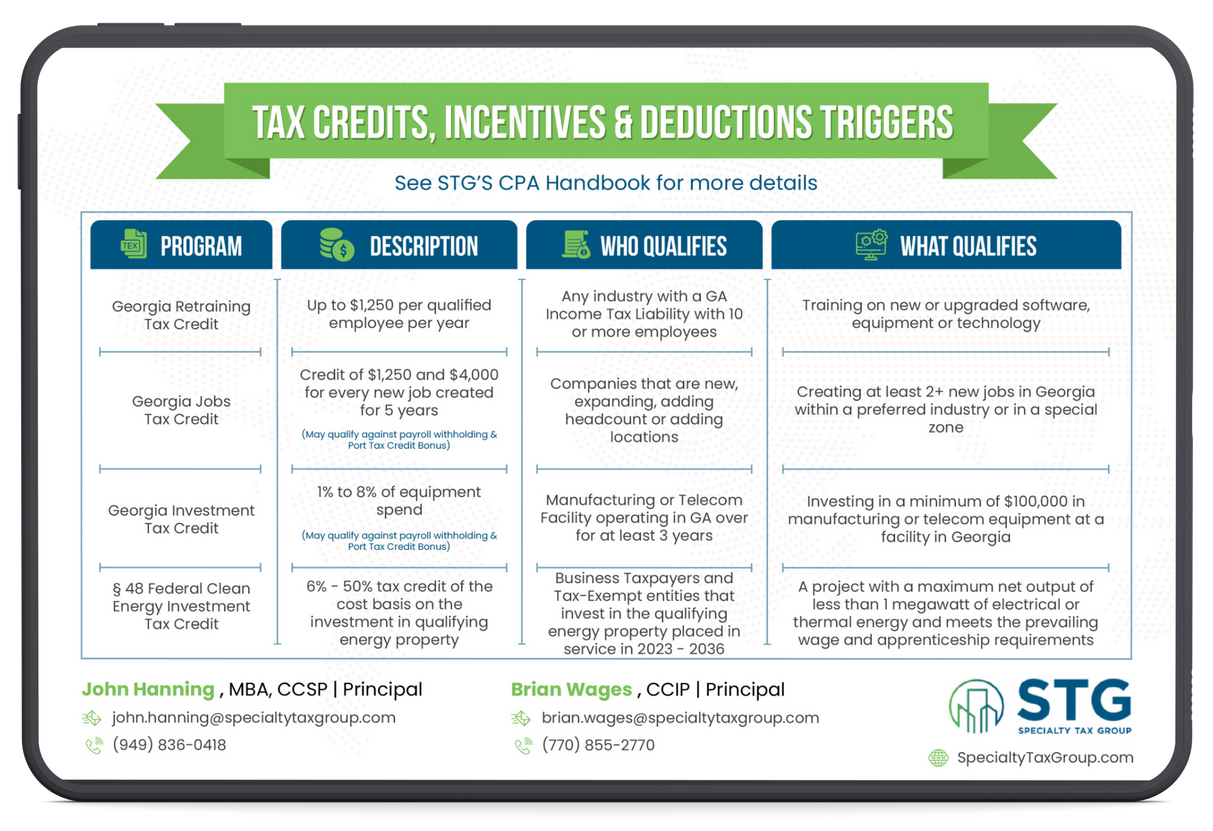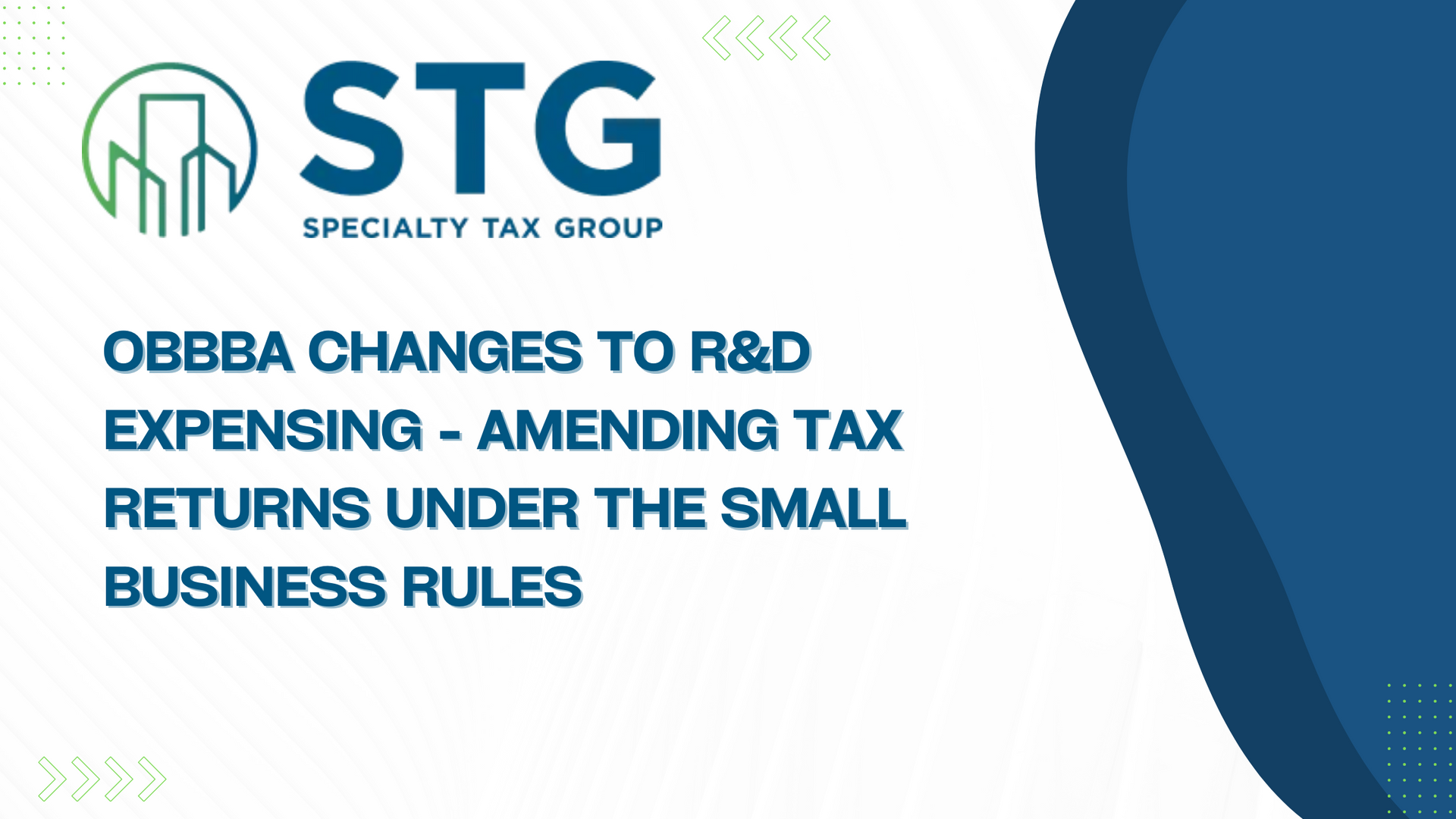This blog post has been researched, edited, and approved by John Hanning and Brian Wages. Join our newsletter below.
The passage of the"One Big Beautiful Bill Act" (OBBBA) in July 2025 brought welcome news to businesses nationwide: 100% bonus depreciation is back. But there's a critical timing element that many property owners and business leaders are still figuring out - the precise meaning of "placed in service" and how it affects eligibility for the full deduction.
For businesses planning major equipment purchases, real estate deals, or construction projects, understanding these timing rules could mean the difference between writing off 100% of an asset's cost versus only 40-60%. With commercial properties and high-value equipment often representing six or seven-figure investments, these percentage differences add up to serious tax savings.
The Important Date: January 20, 2025
Under the OBBBA, any qualifying property acquired and placed in service after January 19, 2025 gets the restored100% bonus depreciation. This is a huge improvement from the phase-down schedule that was in effect earlier in 2025, where bonus depreciation had dropped to just 40% for property placed in service between January 1-19, 2025.
Here's how the timeline looks:
- 2022: 100% bonus depreciation
- 2023: 80% bonus depreciation
- 2024: 60% bonus depreciation
- January 1-19, 2025: 40% bonus depreciation
- January 20, 2025 and beyond: 100% bonus depreciation (permanent)
This creates a unique situation where identical properties placed in service just days apart could qualify for vastly different deduction levels.
The Construction Problem: The 10% Rule Returns
While the January 20, 2025 cutoff seems straightforward, it gets more complicated for construction projects and properties that take time to build. Based on past IRS rules, tax professionals expect the agency to bring back the 10% construction rule for determining placed-in-service dates.
How the 10% Rule Works
Under this rule, if at least 10% of a building or construction project was completed before the critical cutoff date, the entire project may only qualify for the earlier (less favorable) bonus depreciation schedule. This means:
- A commercial building that was 10% complete by January 19, 2025 would likely qualify for only 40% bonus depreciation
- The same building starting construction on January 21, 2025 would qualify for 100% bonus depreciation
This rule exists to prevent taxpayers from gaming the system by artificially changing when property is considered "placed in service."
What Counts as "10% Complete"?
The 10% threshold typically refers to the total cost of construction, not how much of the building is physically done. This could include:
- Site preparation and foundation work
- Materials delivered to the construction site
- Signed contracts with subcontractors
- Architectural and engineering costs
Acquisition vs. Placed-in-Service
The OBBBA creates another timing consideration by focusing on acquisition date as well as placed-in-service date. Property must be both acquired AND placed in service after January 19, 2025 to qualify for 100% bonus depreciation.
Key Point: Even if property is placed in service after January 20, 2025, it won't qualify for 100% bonus depreciation if it was acquired (or subject to a binding contract) before that date. Such property would be limited to the 40% rate that applied to early 2025.
Smart Planning Opportunities
The return of 100% bonus depreciation creates several planning opportunities for businesses:
For New Construction Projects
- Timing matters: Projects beginning after January 19, 2025 have a clear advantage
- Keep good records: Maintain detailed documentation of when construction begins and what costs are incurred when
- Consider breaking projects into phases: Splitting larger projects into phases that start after the cutoff date could maximize benefits
For Equipment Purchases
- Manufacturing equipment: Qualified property with shorter production periods may be easier to time correctly
- Technology investments: Software, computers, and other tech assets are generally easier to time for optimal tax treatment
- Vehicle fleets: Commercial vehicles continue to qualify for bonus depreciation when placed in service after January 19, 2025
For Real Estate Investors
- Acquisition timing: Focus on properties that can be acquired and placed in service after the cutoff
- Improvement projects: Major renovations and tenant improvements starting after January 19, 2025 may qualify
- Mixed-use considerations: Different components of mixed-use properties may have different placed-in-service dates
Common Mistakes to Avoid
The "Delay Game" Won't Work
The IRS specifically designed these rules to prevent taxpayers from artificially delaying placed-in-service dates to qualify for better treatment. Trying to hold back completion of substantially finished projects could trigger scrutiny and potential penalties.
Binding Contract Trap
Remember that the acquisition date is generally when a binding written contract is signed, not when closing happens. A contract signed in December 2024 for property closing in February 2025 would not qualify for 100% bonus depreciation.
Property Type Restrictions
Not all property qualifies forbonus depreciation. The rules generally apply to:
- Tangible personal property with a recovery period of 20 years or less
- Computer software
- Qualified improvement property (with specific limitations)
What's Still Unknown: Waiting for IRS Guidance
While the OBBBA provided the framework for restored bonus depreciation, several technical details remain unclear:
- Specific application of the 10% rule: How exactly will the IRS measure construction completion?
- Safe harbor provisions: Will there be any exceptions or safe harbors for projects that straddle the cutoff date?
- Documentation requirements: What records will taxpayers need to support their placed-in-service determinations?
Tax professionals are closely watching for additional IRS guidance, which could provide clarity on these implementation details.
Working with Cost Segregation
For many property owners, the return of 100% bonus depreciation makescost segregation studies even more valuable. Cost segregation helps identify which components of a building qualify for accelerated depreciation, maximizing the benefit of bonus depreciation rules.
When combined with proper timing around the January 20, 2025 cutoff, cost segregation can help property owners:
- Identify more assets eligible for 100% bonus depreciation
- Properly document placed-in-service dates for different building components
- Maximize first-year deductions through strategic planning
The Bottom Line: Plan Carefully and Document Everything
The return of 100% bonus depreciation represents a major opportunity for businesses to speed up tax deductions and improve cash flow. However, the timing requirements create both opportunities and traps that require careful planning.
Action Steps for Business Owners:
- Review current projects: Check which assets or construction projects might qualify for 100% bonus depreciation
- Document timing carefully: Keep detailed records of acquisition dates, contract signing dates, and construction milestones
- Consult with tax professionals: The interaction between timing rules, property types, and business circumstances requires expert guidance
- Plan future investments: Consider how the permanent nature of this benefit affects long-term capital investment strategies
The January 20, 2025 date will likely prove to be one of the most important dates in recent tax law for businesses with major capital investments. Those who understand and properly navigate the "placed in service" rules will be positioned to maximize their tax benefits, while those who overlook these details may miss out on substantial savings.
As the
IRS releases additional guidance in the coming months, staying informed about
implementation details will be crucial for optimizing tax strategies around this powerful business incentive. For businesses looking to take full advantage of these opportunities, working with experienced tax professionals who understand both the technical requirements and strategic implications can make all the difference in maximizing these valuable tax benefits.
2024 Tax Guide





